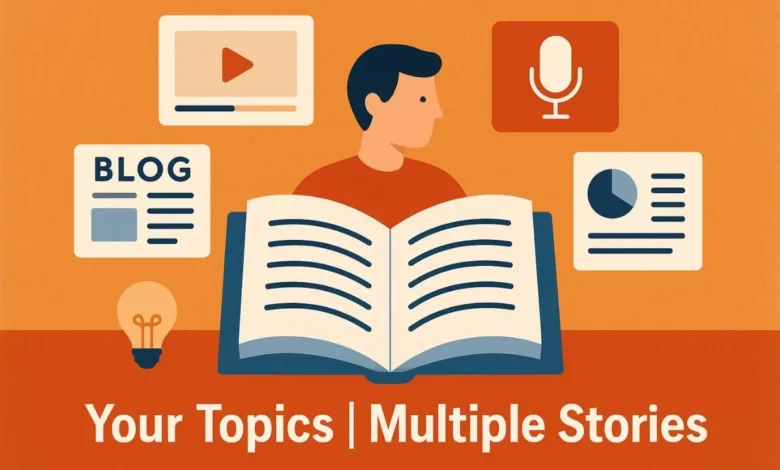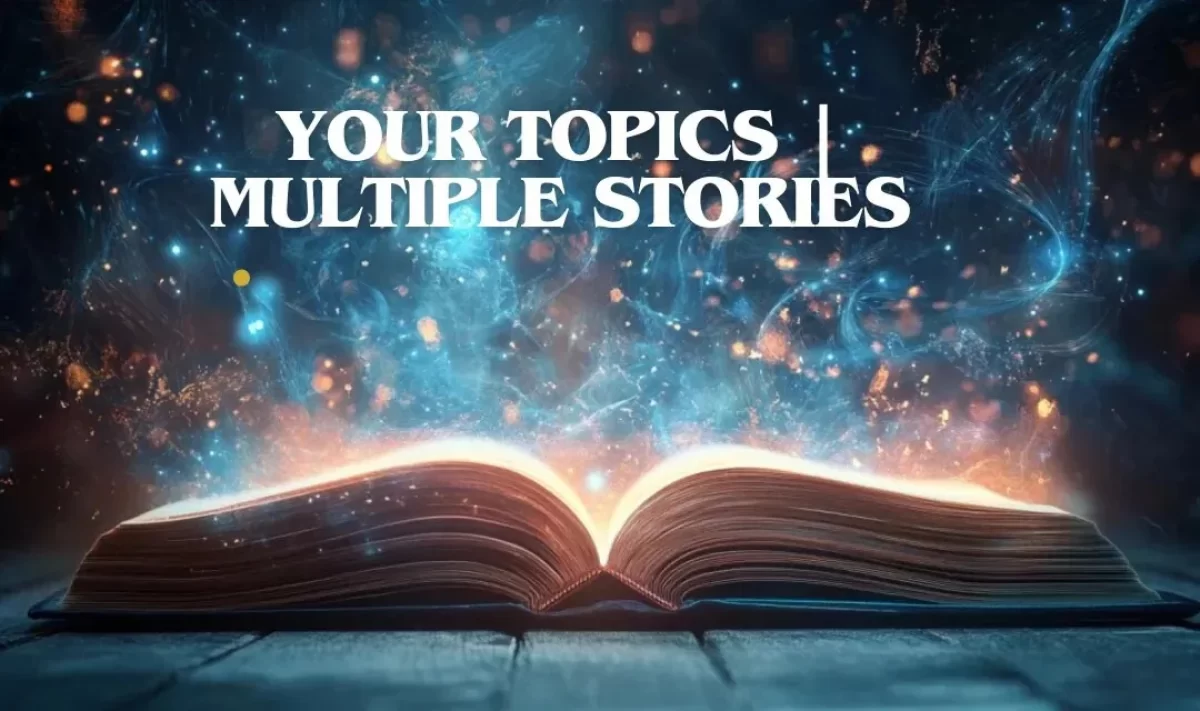Every business, brand, or creator starts with a single idea. Yet in today’s digital world, audiences expect variety, depth, and context. This is where the concept of “your topics multiple stories” comes into play. Instead of producing one piece of content per topic, you can generate multiple narratives that appeal to different audience segments, buyer journey stages, and platforms.
In this guide, you’ll learn exactly what “your topics multiple stories” means, why it matters for SEO and audience growth, and how you can apply it systematically. We’ll explore real-world frameworks, common pitfalls, and advanced tactics that ensure you dominate search rankings and create content that no competitor can easily replicate.

What Does “Your Topics Multiple Stories” Mean?
At its core, “your topics multiple stories” is a strategy that takes one subject and develops several different narratives around it. Instead of publishing a single generic article, you break the topic down into perspectives, formats, and use cases.
For example:
-
Topic: Remote Work Productivity
-
Multiple Stories Could Be:
-
A data-driven analysis on productivity metrics.
-
A human-interest piece featuring employee experiences.
-
A practical listicle with 20 remote work tools.
-
A leadership guide on managing distributed teams.
-
A podcast episode debating myths of remote work.
-
Each story serves a different intent and reaches a broader set of readers, while collectively building topical authority.
Why “Your Topics Multiple Stories” Matters
1. SEO & Search Visibility
Google rewards websites that cover a subject comprehensively. By creating multiple stories for one topic, you:
-
Capture more long-tail keywords.
-
Avoid content thinness.
-
Establish topical authority in your niche.
2. Audience Engagement
Different people consume content in different ways. Some prefer blog posts, others like infographics, videos, or case studies. Multiple stories ensure everyone finds a piece they connect with.
3. Personalization
Modern audiences expect content that speaks directly to their needs. By tailoring stories to beginners, experts, buyers, or casual readers, you keep engagement levels high.
4. Content Longevity
A single topic can fuel your editorial calendar for months. Instead of scrambling for new ideas, you recycle one topic into a content ecosystem.
The Multi Story Content Framework
Here’s a structured framework to turn one topic into many stories that reinforce each other.
Step 1: Research the Core Topic
-
Identify audience pain points.
-
Analyze competitor gaps.
-
Gather data, examples, and expert opinions.
Step 2: Break It into Angles
-
Educational: Guides, tutorials, definitions.
-
Emotional: Case studies, personal journeys.
-
Contrarian: Myths, unpopular opinions.
-
Analytical: Data-driven reports.
-
Actionable: Tools, templates, and checklists.
Step 3: Map Angles to Formats
| Angle | Format Options | Target Audience |
|---|---|---|
| Educational | Blog posts, explainer videos | Beginners & learners |
| Emotional | Interviews, podcasts, storytelling posts | General readers |
| Contrarian | Opinion blogs, debates, short-form videos | Thought leaders |
| Analytical | Whitepapers, infographics, research reports | Professionals |
| Actionable | Checklists, templates, tutorials | Doers & practitioners |
Step 4: Plan Internal Linking
Ensure each story connects back to the main topic hub. This strengthens SEO and improves navigation.
Step 5: Repurpose & Scale
Turn blogs into slides, podcasts into transcripts, data into carousels. This multiplies your reach across platforms.
Example: “Sustainable Fashion” Turned into Multiple Stories
Let’s see how one topic can grow into dozens of stories:
-
Beginner Guide: What is sustainable fashion?
-
Emotional Story: Interview with a designer.
-
Contrarian Piece: Myths about eco-friendly fabrics.
-
Data Analysis: Stats on fashion waste reduction.
-
How-To Listicle: 15 easy ways to shop sustainably.
-
Case Study: A brand’s journey to eco-conscious production.
-
Video Content: Step-by-step upcycling tutorial.
-
Podcast: Roundtable with activists.
-
Infographic: Lifecycle of a sustainable garment.
-
Social Media Series: Daily eco-fashion tips.
Benefits of Multi Story Content
-
Enhanced Visibility: Each piece ranks for unique keywords.
-
Audience Trust: A well-rounded view shows expertise.
-
Increased ROI: More value from one idea.
-
Authority Signals: Google associates your domain with niche mastery.
-
Content Variety: Keeps readers engaged and reduces bounce rate.
Common Mistakes to Avoid
-
Duplication: Rehashing the same content in different words.
-
Overproduction: Publishing too many angles at once.
-
Ignoring SEO: Not assigning distinct keywords to each story.
-
Weak Internal Links: Stories that don’t connect back to a content hub.
-
Surface-Level Content: Shallow articles that add no value.
Best Practices for Success
-
Use a Content Matrix
Map your angles and formats in a simple table to visualize your coverage. -
Focus on Intent
Every piece must target a unique audience intent (informational, transactional, navigational). -
Leverage Storytelling
Even data-heavy pieces should include narratives to hook readers. -
Automate Where Possible
Use AI for ideation, outlines, or repurposing—but always human-edit for tone. -
Track KPIs by Story
Measure engagement, rankings, and conversions per angle.
FAQs on “Your Topics Multiple Stories”
Q1. How is ‘your topics multiple stories’ different from traditional blogging?
Traditional blogging often creates one post per topic. With multiple stories, you break the topic into different narratives, reaching wider audiences and search queries.
Q2. Does creating multiple stories risk duplicate content penalties?
Not if you assign distinct keywords, intents, and interlinking. Always make each story unique in focus.
Q3. How many stories should I create per topic?
Start with 3–5 well-researched stories. Scale based on audience response and SEO performance.
Q4. What formats work best for multiple stories?
Articles, videos, infographics, case studies, podcasts, and social carousels—all depending on audience preference.
Q5. Can this strategy work for small businesses?
Absolutely. Even local businesses can use multiple stories (e.g., customer stories, how-to guides, local data insights).
Q6. Is this approach future-proof for SEO?
Yes. Google increasingly values topical depth and authority, which multi-story content delivers.
Comparing Single vs. Multiple Stories per Topic
| Factor | Single Story Approach | Multiple Stories Approach |
|---|---|---|
| SEO Reach | Limited keyword coverage | Broad, multi-intent coverage |
| Engagement | One type of audience | Multiple audience segments |
| Authority | Thin topical depth | Strong topical authority |
| Longevity | One-off publication | Ongoing content ecosystem |
| ROI | Low return per idea | High return on research |
Tools to Help Build Multiple Stories
-
Keyword Tools – SEMrush, Ahrefs, Google Keyword Planner.
-
Content Planning Tools – Trello, Notion, Airtable.
-
Writing Tools – Grammarly, Hemingway Editor.
-
Design Tools – Canva, Figma, Visme.
-
Repurposing Tools – Descript, Lumen5, Slides AI.
Content Angles You Can Explore
-
Beginner’s guide
-
Advanced guide
-
Step-by-step tutorial
-
Case study
-
Opinion/analysis
-
Myth-busting article
-
Checklist or template
-
Industry trend report
-
Interview/Q&A
-
Infographic or visual story
Learn More: Jobs on Petrol Platform: Complete Guide to Careers Offshore
Why Does Pure Water Dehydrate You? Myths, Truths, and Science Explained
Conclusion
“Your topics multiple stories” is not just a content hack it’s a complete strategy for building topical authority, scaling content marketing, and staying relevant in search rankings. By breaking one idea into multiple unique narratives, you maximize audience engagement, SEO visibility, and long term ROI.

